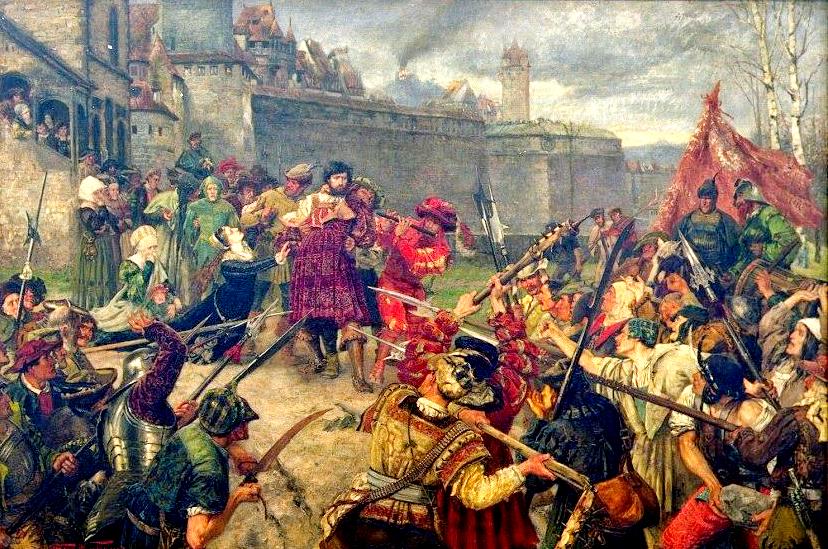
Later Serfdom: Countries--German Serfdom

Figure 1.-- This painting depits an Easter Sunday incident in the German Peasants' War (1525). It occurred in Swabia, southeastern Germany. The peasant rebels executed Count von Helfenstein and 80 others. The peasants were led by Jäcklein Rohrbach, the Schwarze Hofmännin and the “Bright Band” of peasants. The nobels were cught outside Castle Weinsberg and slaughtered in what became known as the Weinsberger Bluttat, the Weinsberg Massacre. We have not yet identified the artist.
|
|
Germany was not a unified nationn state until well after the feudal era this the institution of serfdom varied througout the German cultural area, basiclly the Holy Roman Empire. Prussia would emerge as the doiminant state and acquire areas of western Poland where serfdom still existed as part of ghe Polish Partitions (18th century), as was the case in much of Eastern Europe, at a time it was declining in Prussia itself. The history of serfdom in Germany is somewht different than Western Europe, primarily because a German monarchy and nation state did not develop during the medieval era. Germany remained divided into a few large states and many small principalities. Serfdom develooped thrioughout th German states with differences from state to state. The institution began to decline in western Germany after ghe Black Death and onset of the Renaissance. This was promoted by the quickening of the economy in the late-mediueval era. The German Peasants' War (Deutscher Bauernkrieg) was a widespread popular revolt in German-speaking areas (1524-26). It horrified Luther. It was not jut the peasantry jnvolved, but serfs and peasants with small holdings along with the Anabaptist clergy provided he leadership. The Peasants' War would be Europe's largest and most widespread popular uprising prior to the French Revolution. The uprising failed because of the organized and effectiuve military action organized by the aristocracy. Some 100,000 of the 300,000 poorly led and armed peasants were butchered. The survivors were fined the fedual restructs wre reimposed in a harsher form. As a result serfdom would contiunue in Germany into the 18th century, especially in the East. This conincided with the Later Serfdom in Eastern Europe, but eventully also began declining in western and southern Germany. Serfdom was most fully devlod by the Thirty Years’ War (1618-48) anbd most onerous in Mecklenburg, Pomerania, and East Prussia. In Poland the norms of serfdom became part of the Piotrków Statute (1496). And would be in olace when Prussia acquired western Poland (18th century). The abolition of serfdom did not come until the Frenh Revolution era (1770-1830). Abolition came:-- Schleswig (1780), Prussia (the October Edict -- 1807), Bavaria (1808), and Mecklenburg (1820). Vestiges of serfdom survived long after abolition. The Prussian October edict was the most sweeping.
It upgraded the personal legal status of the peasantry and notably gave them ownership of half or two-thirds of the lands they were working. This alone bound the peasantry to nthe Prussian state, creating a conservative force. The edict covered all peasants whose holdings were above a certain minimum size. It applied to both Crown lands and aristocrtic estates. The peasants were freed from the work obligation to thefeudal lordds (coirvée) and annual dues. The lords (landowners) for their part retained ownership of 1/3 to 1/2 of their land. The other German states genberlly folloed the Prussian example after the Napoleonic Wars (1815). [Sagarra, pp. 341-45] In stark contrast to the violence of the Peasant Wars and French Revolution, Germany handled it the abolition of serfdom peacefully hen it finally came. In a few areas like Schleswig, the peasants had been influenced by the Enlightenment and played an active role. In most of Germny, the peasantry was passive, even in the eastern areas where serfdom was still intrenched (East Prussia and what is now western Poland. For most of the peasants, customs and traditions continued little cnged. Culturally the the traditional pattern of deference to the aristocracy continued. And the the lnd-owning aristocracy retaimed condsiderablr legal authority over the villagers which continued after Germany was unified around he Prussian monsrchy (1871). The paternalistic relationship in East Prussia lasted into the NAZI and World War II era. What was achieved was the German peasantry was fully enfranchised, could now sell his land, buy land, and move into the city. [Sagarra, pp. 341-45]
Sources
Sagarra, Ewa. A Social History of Germany.
CIH

Navigate the Children in History Website:
[Return to the Main serfdom page]
[Return to the Main forced labor page]
[Return to the Main feudalism page]
[Return to the Main working page]
[Return to the Main activities page]
[Introduction]
[Biographies]
[Chronology]
[Climatology]
[Clothing]
[Disease and Health]
[Economics]
[Geography]
[History]
[Human Nature]
[Law]
[Nationalism]
[Presidents]
[Religion]
[Royalty]
[Science]
[Social Class]
[Bibliographies]
[Contributions]
[FAQs]
[Glossaries]
[Images]
[Links]
[Registration]
[Tools]
[Children in History Home]
Created: 3:56 PM 7/23/2018
Last updated: 1:48 PM 7/24/2018



